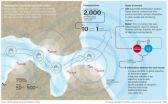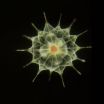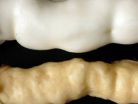(Press-News.org) The system has been designed by scientists from this Madrid university for Núcleo CC, a company which develops surveillance systems for the maritime and aeronautic sectors. The first prototype will be used in the near future in Cape Verde (Africa). Two types of sensors have been deployed there: a set of radars and a series of AIS (Automatic Identification System), which allow ships to communicate their position and give other relevant data on their location and characteristics. These two types of sensors offer complementary data which can be fused in order to obtain better information as to what is happening in the maritime and coastal space of the area of interest. This has been achieved by the scientists from the Applied Artificial Intelligence Group (GIAA) of UC3M, who have carried out the project "Fusión de Información en Tráfico Marítimo" (Information Fusion in Marine Traffic).
The results of this research, presented last July at the International Conference on Information Fusion in Edinburgh, Scotland, has been the creation of data fusion software which allows improved maritime surveillance to be carried out, simultaneously integrating the capabilities of the radars and the AIS localization stations deployed. The objective is to guarantee security in the area by monitoring the different ships that are in a given maritime route which, at the same time is the entrance and exit of a commercial port. "For that", Jesus Garcia, one of the heads of the study from the UC3M Department of Information Technology, pointed out, "it is necessary to have a complete, accurate, and up to date picture, similar to that which is provided to air traffic controllers, of all the ships that are in the area of coverage to be able to adequately manage maritime traffic and to detect anomalies as much in advance as possible".
The scientists developed a prototype which has been integrated into the company's system, after having undergone validation tests to be able to execute in real time with the data supplied by its sensors. It able to monitor 2,000 identifiable objectives between large and small vessels, with a capacity to process the data of up to 10 sensors and provide the exit with one second refresh time. "Ships have to be able to localized 24 hours a day, 7 days a week, 365 days a year, independent of failures in the sensors or in the different intermediate mechanisms, and in some way, what this system attempts to do is guarantee that this can be done", explained José Luis Guerrero, another of the GIAA group researchers, who worked on this project from the UC3M Colmenarejo Campus. "In this way", he continued", we are able to make it so these vessels never lose their position thus avoiding collisions or any type of problem in information management regarding the movement dynamics of these ships".
This first prototype opens the way for posterior analysis and development, as more data and information regarding its functioning under real conditions are obtained, the scientists noted, who are now researching how to apply this information fusion technology to fields such as robotics, in unmanned vehicle navigation, artificial vision, or environmental intelligence systems. "In all of these areas", Professor Jesus Garcia pointed out, "information fusion technology and infrastructure are necessary to combine the data from available sensors and the contextual information in each scenario".
INFORMATION:
An intelligent system for maritime surveillance has been created
2010-10-05
ELSE PRESS RELEASES FROM THIS DATE:
MBL scientists reveal findings of World Ocean Microbe Census
2010-10-05
LONDON, UK—After a decade of joint work and scientific adventure, marine explorers from more than 80 countries, including six scientists from the Marine Biological Laboratory (MBL), today delivered the first global Census of Marine Life revealing what, where, and how much lives and hides in the world's oceans. In one of the largest scientific collaborations ever conducted, more than 2,700 scientists spent over 9,000 days at sea on more than 540 expeditions gathering the data.
As a result of these efforts the scientists discovered that there may be up to 1 billion kinds ...
New report examines university management of intellectual property
2010-10-05
WASHINGTON — The system put in place by the Bayh-Dole Act of 1980 -- which gives universities significant control over intellectual property associated with the results of federally funded research at their institutions – has been more effective than the pre-1980 system in making research advances available to the public and spurring innovation, says a new report from the National Research Council. Nevertheless, the current system needs improvement, said the committee that wrote the report.
"The public investment in research universities has led to a great deal of new ...
Surprise: Scientists discover that inflammation helps to heal wounds
2010-10-05
A new research study published in The FASEB Journal (http://www.fasebj.org) may change how sports injuries involving muscle tissue are treated, as well as how much patient monitoring is necessary when potent anti-inflammatory drugs are prescribed for a long time. That's because the study shows for the first time that inflammation actually helps to heal damaged muscle tissue, turning conventional wisdom on its head that inflammation must be largely controlled to encourage healing. These findings could lead to new therapies for acute muscle injuries caused by trauma, chemicals, ...
Technology transfer and postdoc entrepreneurs
2010-10-05
Post-doctoral researchers see their role as being vital in technology transfer where scientific findings become useful to the local economy, but most have little interest in running their own business once their research fellowship ends. That's the surprising finding of a study published in the International Journal of Knowledge-Based Development.
Edmund Zolnik, a public policy specialist at the George Mason University, in Arlington, Virginia, has surveyed postdoctoral fellows in the US National Capital Region. He found that most saw technology transfer as an important ...
Mechanism involved in addictions and some forms of obesity discovered in U of A lab
2010-10-05
A researcher from the Faculty of Medicine & Dentistry at the University of Alberta has discovered a mechanism underlying some forms of obesity and addictions which could lead to a treatment for both diseases.
When a hungry animal finds food in the wild, it is a rewarding stimulus for the animal and is recognized by the brain by the release of the chemical messenger dopamine. Because narcotics such as cocaine, heroin and amphetamines, and even tasty and highly-caloric foods also cause the release of dopamine and therefore make people feel rewarded, it's clear that dopamine ...
Using cassava to address vitamin A deficiency
2010-10-05
The roots of cassava (Manihot esculenta) serve as the primary source of carbohydrates in the diets of people in many arid regions of the world, including more than 250 million people in sub-Saharan Africa. Unfortunately the roots of commercial cassava cultivars are quite low in micronutrients, and micronutrient deficiencies are widespread in these regions. In addition to programs designed to deliver vitamin supplements, there has been considerable effort aimed at biofortification; that is, increasing the amounts of available micronutrients in staple crops such as cassava. ...
John Theurer Cancer Center to present innovative research at 2 surgical meetings
2010-10-05
HACKENSACK, N.J. (October 4, 2010) — James C. Wittig, M.D. and colleagues will conduct a total of eight research presentations at the upcoming 96th Annual Clinical Congress of the American College of Surgeons and the 65th Annual Meeting of the American Society for Surgery of the Hand. Dr. Wittig, an orthopedic oncologist with extensive experience in performing limb-sparing surgeries, is Chief of the Division of Skin and Sarcoma Cancer of the John Theurer Cancer Center at Hackensack University Medical Center.
The presentations will focus on unique surgical techniques ...
First-of-its-kind study finds alarming increase in flow of water into oceans
2010-10-05
Irvine, Calif. — Freshwater is flowing into Earth's oceans in greater amounts every year, a team of researchers has found, thanks to more frequent and extreme storms linked to global warming. All told, 18 percent more water fed into the world's oceans from rivers and melting polar ice sheets in 2006 than in 1994, with an average annual rise of 1.5 percent.
"That might not sound like much – 1.5 percent a year – but after a few decades, it's huge," said Jay Famiglietti, UC Irvine Earth system science professor and principal investigator on the study, which will be published ...
Montana State team finds rare oasis of life on floor of Yellowstone Lake
2010-10-05
BOZEMAN, Mont. -- Montana State University researchers have discovered a rare oasis of life in the midst of hundreds of geothermal vents at the bottom of Yellowstone Lake.
A colony of moss, worms and various forms of shrimp flourishes in an area where the water is inky black, about 90 degrees Fahrenheit, and a cauldron of nutrients, gases and poisons, the researchers reported in the September issue of Geobiology.
The vent is close to 100 feet below the surface of Yellowstone Lake and a third of a mile offshore in the West Thumb region. The worms and shrimp live among ...
Mayo Clinic takes the lead in clinical research data management
2010-10-05
ROCHESTER, Minn. -- Mayo Clinic is making it easier for industry sponsors and investigators at sites across the country to collaborate with Mayo on complex and groundbreaking research studies and clinical trials.
In a move aimed at optimizing accuracy, speed and efficiency in clinical research, Mayo Clinic has implemented a front-line system of technology for electronic data capture and management, according to Gloria Petersen, Ph.D., Mayo Clinic associate dean for research informatics. "Mayo's Clinical Trials Management System (CTMS) will eliminate the duplication, delays ...


